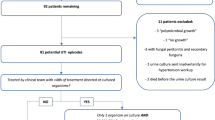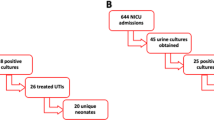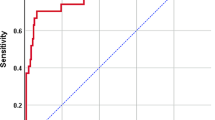Abstract
Objective
Determine the significance of urinary tract infection (UTI) as a cause of late onset sepsis (LOS) in very low birth weight (VLBW) infants in the Neonatal Intensive Care Unit (NICU).
Study design
Analysis of blood, cerebrospinal fluid and urine culture results in VLBW infants >72-h old, admitted to the Georgetown University Hospital NICU between 2005 and 2015.
Result
Of 527 VLBW infants, 297 (56.4%) underwent 911 evaluations for LOS; only one-third included urine cultures. UTI was diagnosed in 8.5% of VLBW infants (range 2–15.9%) and in 13.8% of infants weighing < 1000 g at birth. Gram-negative infections predominated. Concomitant blood cultures were negative in 96% of infants. UTI was more common than bloodstream infection by 2015.
Conclusion
UTI is a significant cause of infection in VLBW infants. Urine culture should be included in all LOS evaluations in order to facilitate accurate diagnosis and appropriate antibiotic therapy.
This is a preview of subscription content, access via your institution
Access options
Subscribe to this journal
Receive 12 print issues and online access
$259.00 per year
only $21.58 per issue
Buy this article
- Purchase on Springer Link
- Instant access to full article PDF
Prices may be subject to local taxes which are calculated during checkout




Similar content being viewed by others
References
Shah DK, Doyle LW, Anderson PJ, Bear M, Daley AJ, Hunt RW, et al. Adverse neurodevelopment in preterm infants with postnatal sepsis or necrotizing enterocolitis is mediated by white matter abnormalities on magnetic resonance imaging at term. J Pediatr. 2008;153:170–5.
Mitha A, Foix-L ‘Hélias L, Arnuad C, Marret S, Vieux R, Aujard Y, et al. Neonatal infection and 5-year neurodevelopmental outcome of very preterm infants. Pediatrics. 2013;132:e372–80.
Schlapbach LJ, Aebischer M, Adams M, Natalucci G, Bonhoeffer J, et al. Impact of sepsis on neurodevelopmental outcome in a Swiss National Cohort of extremely premature infants. Pediatrics. 2011;128:e348–57.
Stoll BJ, Hansen N, Fanaroff AA, Wright LL, Carlo WA, Ehrenhranz RA, et al. Late onset sepsis in very low birth weight neonates: the experience of the NICHD Neonatal Research Network. Pediatrics. 2002;110(2 Pt 1):285–91.
Boghossian ND, Page GP, Bell EF, Stoll BJ, Murray JC, Cotton CM, et al. Late-onset sepsis in very low birth weight infants from singleton and multiple-gestation births. J Pediatr. 2013;162:1120–4.
Bowen JR, Callander I, Richards R, Lindrea KB. Decreasing infection in neonatal intensive care units through quality improvement. Arch Dis Child Fetal Neonatal Ed. 2017;102:F51–7.
Fisher D, Cochran KM, Provost LP, Patterson J, Bristol T, Metzquer K, et al. Reducing central-line associated bloodstream infections in North Carolina NICUs. Pediatrics. 2013;132:e1664–71.
Almeida CC, Pissarra da Silva SMS, Flor de Lima Caldas de Oliveira FSD, Guimarães Pereira Areias MHF. Nosocomial sepsis: evaluation of the efficacy of preventive measures in a level-III neonatal intensive care unit. J Matern Fetal Neonatal Med. 2017;30:2036–41.
Bizzarro MJ, Shabanova V, Baltimore RS, Dembry LM, Ehrenkranz RA, et al. Neonatal sepsis 2004-2013: the rise and fall of coagulase-negative staphylococci. J Pediatr. 2015;166:1193–999.
Bauer S, Eliakim A, Pomeranz A, Regev R, Litmanovits I, Amon S, et al. Urinary tract infection in very low birth weight preterm infants. Pediatr Infect Dis J. 2003;22:426–30.
Ruangkit C, Satpute A, Vogt BA, Hoyen C, Viswanathan S. Incidence and risk factors of urinary tract infection in very low birth weight infants. J Neonatal Perinat Med. 2016;9:83–90.
Levy I, Comarsca J, Davidovits M, Klinger G, Sirota L, Linder N. Urinary tract infection in preterm infants: the protective role of breastfeeding. Pediatr Nephrol. 2009;24:527–31.
Mohseny AB, van Velze V, Steggerda SJ, Smits-Wintjens VEHJ, Bekker V, Lopriote E. Late-onset sepsis due to urinary tract infection in very preterm neonates is not uncommon. Eur J Pediatr. 2018;177:33–8.
Clarke D, Gowrishankar M, Etches P, Lee BE, Robinson JL. Management and outcome of positive urine cultures in a neonatal intensive care unit. J Infect Public Health. 2010;3:152–8.
Weems MF, Wei D, Ramanathan R, Barton L, Vachon L, Sardesai S. Urinary tract infections in a neonatal intensive care unit. Am J Perinatol. 2015;32:695–702.
Foglia EE, Lorch SA. Clinical predictors of urinary tract infection in the neonatal intensive care unit. J Neonatal Perinat Med. 2012;5:327–33.
Tamim MM, Alesseh H, Aziz H. Analysis of the efficacy of urine culture as part of sepsis evaluation in the premature infant. Pediatr Infect Dis J. 2003;22:805–8.
Sastre JB, Aparicio AR, Cotallo GD, Colomer BF, Hernández MC. Grupo de Hospitales Castrillo. Urinary tract infection in the newborn: clinical and radio imaging studies. Pediatr Nephrol. 2007;22:1735–41.
Roberts KB. Subcommittee of urinary tract infection. Steering Committee on Quality Improvement and Management: urinary tract infection: clinical practice guideline for the diagnosis and management of the initial UTI in febrile infants and children 2 to 24 months. Pediatrics. 2011;128:595–610.
Cotton CM. Adverse consequences of neonatal antibiotic exposure. Curr Opin Pediatr. 2016;28:141–9.
Carr D, Barnes EH, Gordon A, Isaacs D. Effect of antibiotic use on antimicrobial antibiotic resistance and late-onset neonatal infections over 25 years in an Australian tertiary neonatal unit. Arch Dis Child Fetal Neonatal Ed. 2017;102:F244–50.
Cantey JB, Wozniak PS, Sánchez PJ. Prospective surveillance of antibiotic use in the neonatal intensive care unit: results from the SCOUT study. Pediatr Infect Dis J. 2015;34:267–72.
Jacqz-Aigrain E, Zhao W, Sharland M, van den Anker JN. Use of antibacterial agents in the neonate: 50 years of experience with vancomycin administration. Semin Fetal Neonatal Med. 2013;18:28–34.
Author information
Authors and Affiliations
Corresponding author
Ethics declarations
Conflict of interest
The authors declare that they have no conflict of interest.
Rights and permissions
About this article
Cite this article
Drumm, C.M., Siddiqui, J.N., Desale, S. et al. Urinary tract infection is common in VLBW infants. J Perinatol 39, 80–85 (2019). https://doi.org/10.1038/s41372-018-0226-4
Received:
Revised:
Accepted:
Published:
Issue Date:
DOI: https://doi.org/10.1038/s41372-018-0226-4
This article is cited by
-
Urinary tract infections in very premature neonates: the definition dilemma
Journal of Perinatology (2024)
-
Treatment of positive urine cultures in the neonatal intensive care unit: a guideline to reduce antibiotic utilization
Journal of Perinatology (2021)
-
Meningitis, urinary tract, and bloodstream infections in very low birth weight infants enrolled in a heart rate characteristics monitoring trial
Pediatric Research (2020)



